This year, several ChemPubSocEurope Journals are celebrating their anniversaries. Both Chemistry – A European Journal and ChemBioChem were (co-)founded by Peter Gölitz, Editor Emeritus of Angewandte Chemie. Editorials co-written by Peter Gölitz, in which he reflects on the founding process and the European spirit, can be found in both journals.
25 Years of Chemistry – A European Journal
The idea of a European journal of chemistry had been discussed since the 1960s. However, at the time, the European chemical societies were not ready yet to give up their individual journals in favor of a European alternative. In 1993, Nobel Laureate Jean-Marie Lehn and Peter Gölitz, then Editor-in-Chief of Angewandte Chemie, met at a conference in Munich, Germany, discussed the possibility of a European chemistry journal, and got the process started.
Everybody was on board with the idea: The start of a new journal with the help of Angewandte Chemie, which had a solid reputation already. The journal was named Chemistry – A European Journal. The journal’s slogan “Made in Europe for the world” expressed the hope that Americans would publish in the new journal just as Europeans were publishing in American journals, etc., and was based on the conviction that science is an international enterprise.
Other European chemical societies soon participated, which triggered the founding of EUChemSoc (Editorial Union of Chemical Societies), later renamed ChemPubSoc Europe. This collaboration of 16 chemical societies in Europe publishes 15 successful chemistry journals and the magazine ChemViews.
20 Years of ChemBioChem
After the founding of Chemistry – A European Journal in 1995, a range of national chemistry journals from various European countries and societies were merged into the European Journal of Inorganic Chemistry and the European Journal of Organic Chemistry, and in 2000, ChemBioChem and ChemPhysChem debuted.
The 1990s were not only a decade in which the European spirit was thriving, it was also the decade in which chemical biology took off as a discipline of its own. ChemBioChem was founded at the end of that decade, when the chemistry of carbohydrates, nucleic acids, peptides, proteins, and natural products had reached a level that allowed biological questions to be probed. Today, there is no end in sight to studying biological matter with chemical insight and tools and to making use of powerful biological methods and synthetic biology to produce chemicals.
- Cutting a Gordian Knot: The Founding of Chemistry — A European Journal,
Peter Gölitz,
Chem. Eur. J. 2020, 26, 9–10.
https://doi.org/10.1002/chem.201905081 - ChemBioChem@20—Some Reflections,
Alan R. Fersht, Peter Gölitz, Jean‐Marie Lehn,
ChemBioChem 2019, 21, 5–6.
https://doi.org/10.1002/cbic.201900658




